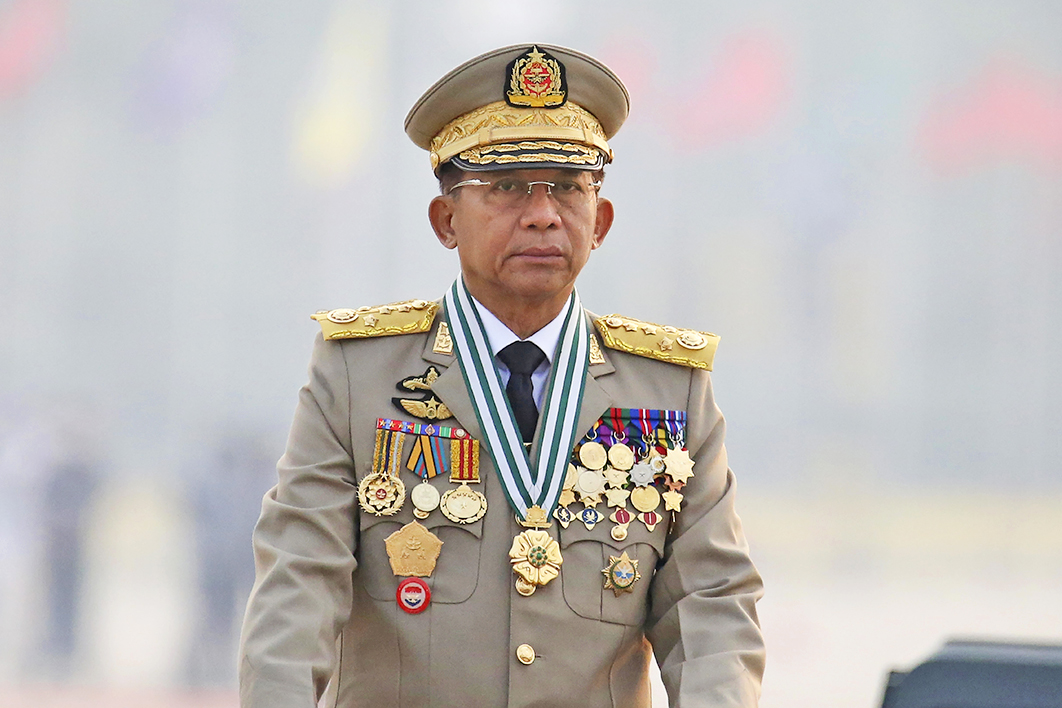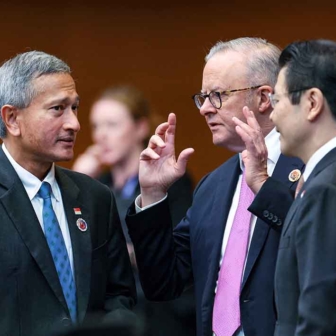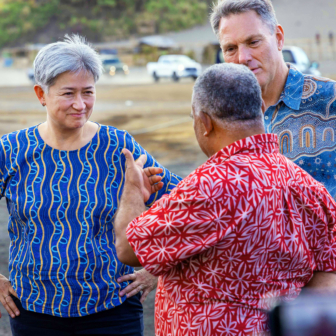Three enormous portraits — of General Aung San, General Ne Win and Senior General Than Shwe — hang in the foyer of the Defence Services Museum in Myanmar’s capital, Naypyitaw. All three of the men depicted were central to the military’s dominance of Myanmar politics.
When I recently showed the paintings to a group of University of Tasmania students, they examined them closely and then made a striking observation: over the decades, Myanmar’s top generals have added layer upon layer of “bling” to their uniforms. The founder of Myanmar’s modern army, Aung San, is pictured in a spartan commander’s coat. Ne Win’s cap and jacket are embellished in gold. Than Shwe, who led the armed forces — the Tatmadaw — into the twenty-first century, glitters with layers of medals and insignia.
Min Aung Hlaing, the current commander-in-chief, takes his cue from this acceleration in military pomp. After ten years at the top, his February 2021 coup against the elected government is defined by hubris and personal ambition.
On this year’s Armed Forces Day, always an exercise in militaristic bombast, his subordinates organised drones to illuminate the night sky in a coordinated show of support for the top man. And when he left Myanmar for the ASEAN summit in Jakarta last week, he was farewelled by a line-up of dignitaries ordered to demonstrate their fealty as the top commander boarded his plane.
Whatever medals the military men award themselves, though, the verdict of Myanmar’s people on this year’s coup is clear. Their preference for the National League for Democracy, whatever its faults, was first demonstrated when Aung San Suu Kyi was elected to the Pyithu Hluttaw in 2012 and resoundingly confirmed at the 2015 and 2020 general elections. They want civilian leaders who can freely implement a federal union, bring peace between ethnic groups and shape a more inclusive economy.
The fact that such preferences often count for little among the ASEAN countries frustrates Southeast Asia’s democrats. Vietnam, Laos and Brunei remain autocracies; electoral processes in Cambodia, Thailand and Singapore are tightly controlled. Politics in Indonesia, the Philippines and Malaysia might be more competitive, but many of their citizens are understandably bemused when their systems are presented as models of more inclusive governance.
And so, when he arrived in Jakarta, Min Aung Hlaing could be confident that the instincts of Southeast Asia’s decision-makers would tilt comfortably away from condemnation and towards gentle compromises and the logic of inaction. With consensus an abiding ASEAN objective, his strategists would not have fretted about the prospect of heavy-handed intervention from the neighbours.
For the regional grouping, democratic practices and principles are never primary considerations, even in the wake of a coup. Myanmar’s policy elite knows that it was the internationally condemned violence against protesters ordered by the top generals, and the potential for even more horrendous humanitarian calamity, that finally pushed ASEAN to respond.
ASEAN will send a senior representative to begin discussions with the Myanmar government and, ideally, with a wide range of elected and ethnic political interests. It will be one of the toughest jobs in diplomacy — especially in the face of continued crackdowns and a more aggressive pushback from protesters and some of Myanmar’s heavily armed ethnic groups.
One risk for ASEAN is that its feeble diplomacy will only reinforce demands for a revolutionary outcome. And a push for revolution in Myanmar, even if it fails, will have consequences elsewhere too.
General Prayuth Chan-ocha in Bangkok, the communist hardmen in Vientiane and Hanoi, Hun Sen in Cambodia, the Sultan of Brunei — all share a mutual survival pact framed by ASEAN’s preference for “non-intervention” in sensitive domestic affairs. The ASEAN club’s habit is to protect its own.
The ASEAN club has minimal leverage, a patchy track record and an ingrained caution about the scope of Myanmar-focused diplomacy. Even the serious prospect of a spiral into a decade of war and misery has generated only a modest plan for diplomatic engagement.
Yet without a negotiated settlement — and there seems little immediate prospect of Min Aung Hlaing sitting down with his opponents, let alone striking a deal — ASEAN will face at least some of the flow-on from Myanmar’s deteriorating political, economic and health conditions.
There is now no doubt that Myanmar’s people will need to fight for their futures against a top general who will manipulate international opinion to forestall any diminution of his own status. Some of Myanmar’s protesters are showing their determination to fight back with whatever weapons they can muster. Guerilla warfare tactics — targeting government bases, soldiers and aircraft — drown out ASEAN’s calls for restraint.
Attacks by well-established ethnic armed groups are part of this pattern, but more worrying for government security personnel are the ambushes they face in some urban areas. Brutal fighting continues.
Some troops will get shiny medals for their loyalty to Min Aung Hlaing, but they are also earning the hatred of the Myanmar people. Where ASEAN usually prizes restraint and reconciliation, Myanmar’s revolutionaries are striking out to completely upend the established order. Only the victors will keep their portraits on the wall. •




